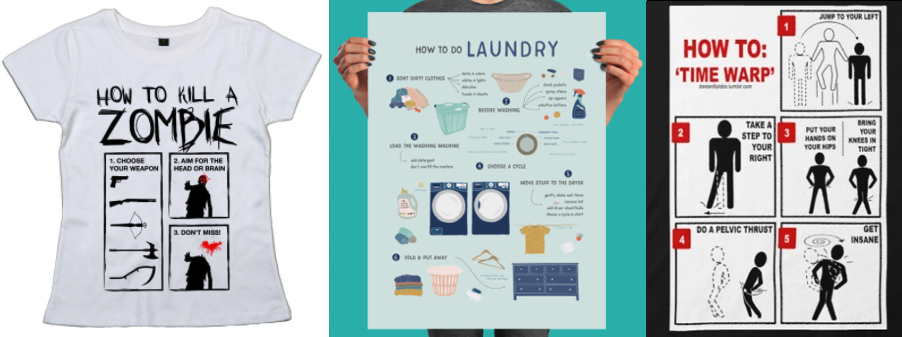
6 Free T-Shirt Idea Methods For Any Niche, Topic or Trend (A Step-By-Step Guide)
by Michael Essek · Updated: April 26, 2021Generating original design ideas is a skill every T-Shirt designer should develop.
If you can come up with unique, funny and witty ideas on-demand – then you can hop on the latest trend with ease, create loads of winning designs to build your brand, and flood your Print on Demand accounts with high numbers of buyer-friendly products.
In this Step-by-step guide I’ll share 6 Idea generation techniques that will work for ANY niche, topic, trend or market – simply follow the steps below and you’ll be generating your own unique ideas in no time at all.
Note: If you find this guide useful, then you’ll love my Ideas Workshop course – a comprehensive class teaching everything I know about creating original design ideas that sell. Find out more here.
Ok – let’s get into the guide, and start generating some original ideas!
6 T-Shirt Idea Methods:
Method 1: (X) Gang

This is a super-simple, versatile framework with almost endless variations.
The (X) Gang Method simply labels the wearer as belonging to a certain group, gang, club or tribe of some kind.
People love to identify themselves as members of some kind of organisation (real or imaginary) – and every club needs an accompanying T-Shirt.
(X) Gang Examples:
- Black Coffee Drinkers Club
- Girl Gang
- Unicorn Squad
Why Is The (X) Gang Method Worth Using?
The (X) Gang framework is a standard T-Shirt format that makes sense to wearer and observer alike – so there’s very little explanation needed. People naturally get the idea – and it is perfect for the medium of a T-Shirt.
People love to wear (X) Gang based shirts – because it makes a statement of affiliation and ‘labels’ the wearer.
Plus it’s very easy to adapt to almost any topic or trend…because there are many different ways of saying ‘club’. And those many ways can lead to extra levels of humour – eg. Alliteration, rhyming, puns and juxtaposition.
How To Use The (X) Gang Method
- Start with your topic, trend or market in mind – and list out potential words related to that topic. Ask questions like: “what words are associated with this topic or trend?”
- Take your list of related words and compare it to a list of synonyms for a word such as ‘club’ or ‘gang’ (you can use this list on Thesaurus.com, for example)
- Run through the two lists to see if there are any pairs that work together (either as rhymes or as alliteration, or just as a pleasant phrase that would make for a good design).
(X) Gang Example Workflow:
Topic: Gardening
List of related words: flowers, plants, ho, pots, tomatoes, vegetables, dirt, cactus, succulents, landscaping.
Synonym list: https://www.thesaurus.com/browse/gang
Results: Gardening Gang, Flower Family (or Flower Fam), Plant Posse, Pot Pack, Tomato Troop, Cactus Crew, Succulents Squad, Landscapers League
Any of these example outputs would make a great starting point for an original design.
As you can see with these examples – I’ve gone down the alliteration route (words that start with the same letters or sounds) – as that’s often something that works well and just ‘rolls of the tongue’.
But you might also find a pair of words that rhyme – which is even better.
(X) Gang Bonus Points…
Adding additional text or context to pad out the design can really take things up a notch. You can try adding extra bits like:
- Property of…
- Proud Member of…
- I’m In The…
- Join Your Local…
- …est. 1895 (or whatever date – to give it an extra authenticity – as though it were a real organisation)
- …San Diego, California (or whatever location – again, to give authenticity)
…plus, if you can devise a motto or tagline for your gang – that also works as a nice addition too.
Now all you have to do is bring it all together in a suitable logo-type or badge-type design for your newly founded club.
And there you have it – The (X) Gang Method. A quick and easy way to come up with catchy ‘Club based’ ideas that you can apply to any niche, community, subject or trend.
Method 2: The ‘How To’ Framework

The ‘How To Framework’ is an example of a visual based layout framework that…
- is fun to brainstorm
- is completely evergreen
- works for any subject or market
…and produces concepts that work brilliantly on T-Shirts, Posters and many other products.
How To Use The How-To Framework
The process is very simple: you’re going to create step-by-step ‘How To’ Instructions related to your topic.
First – imply ask yourself: what’s an example of an objective that my target audience is trying to achieve?
For example, if your subject is gardening – objectives might be:
- How To Grow Tomatoes
- How To Keep Slugs Off our Lettuces
- How To Grow The World’s Biggest Pumpkin
That’s easy enough right?
From there you simply create a design that delivers on that headline promise.
(In other words, you show your audience how to achieve stated aim – step by step – with accompanying graphics).
Here are some really simple examples of ‘How To’ designs:
…as you can see, this framework is super flexible.
Plus ‘How To’ designs don’t have to be super complex – and there’s lots of room for humour and additional layers of jokes.
For bonus points and extra humour – you can render your design as an Ikea-style instruction booklet – such as the following examples:
- Musketon’s Nikea (how to assemble a Nike trainer for sneaker fans)
- How To Assemble Stone Henge
- How to Create a Dinosaur
You can also take popular slang phrases or idioms and use this framework to create a ‘double meaning’ based joke – for example: ‘How To Pick Up Chicks’ or ‘How To Cheat Death‘.
So now you know about The How To Framework – make a note of it, and try it out when you’re trying to come up with new, more interesting ideas. The great thing about The How To Framework is that the ideas you generate are usually much more ‘meaty’ – meaning you have lots of opportunity for extra jokes, and for detailed, original illustrations.
Method 3: The Opposites Method

The Opposites Method is a way to come up with unique funny phrases by looking for ‘opposite’ words in well-known idioms or sayings.
Some examples of the Opposites Method in action include:
The underlying principle behind this method is simple: when you take a well known phrase and ‘reverse’ or ‘invert’ one of the words – you create a humorous contrast, which can form the basis of a funny design.
(This method works for generating your own phrases – how you render that as a design is up to you.)
So – how do you use the Opposites Method?
Here’s a step by step:
How To Use The Opposites Method
(You’ll need a subject or topic in mind – but once you have that…)
- Find a word related to your topic that has a clear ‘opposite’ word (Antonym). You’re looking for an ‘opposite’ that is likely to appear in at least a few well-known phrases or sayings.
- Find phrases or sayings that include your ‘opposite’ word. You can use a site like The Idioms Dictionary for this.
- Once you have a suitable idiom, simply swap out your ‘opposite’ word for your original word.
The Opposites Method Example Workflows:
Let’s take ‘Valentines Day‘ as our subject.
A word related to Valentines Day that has a clear opposite word is: Love. (opposite word: Hate).
So we just need to find an idiom or phrase featuring the word ‘hate’.
…..such as: ‘Haters Gonna Hate‘.
Now we simply switch our original word for the opposite word – and arrive at: ‘Lovers Gonna Love‘.
One More Example:
Subject: Dinosaurs – or more specifically – Diplodocus.
What’s a word related to Diplodocus which has a clear ‘opposite’?
Well, Diplodocus has a long neck and tail – so we could use the word Long – and the antonym Short.
I looked for idioms that include the word ‘short’ – and came up with:
- Short Back and Sides
- Life Is Short
So now we just swap out ‘short’ for ‘long’ – and we arrive at:
- Long Back and Sides
- Life Is Long
…both of which could be the makings of a neat design concept (alongside a cute Diplodocus illustration of course).
Top Tip: to expand your word options and opposites, put your related words into thesaurus.com first. Not only will this broaden your input words, but it also includes a clear ‘Opposites of…’ section – which can help you brainstorm more specific and as-yet un-tapped ideas.
Method 4: The Simple Text Switcheroo

The Simple Text Switcheroo takes a simple phrase or saying and renders it in an unexpected style.
The Simple Text Switcheroo works because of the juxtaposition between the ‘message’ (the text) and the ‘delivery’ (the style).
The message carries one meaning – but the style in which it is delivered carries a very different meaning. Hence a conflict – a contrast – and (hopefully) – humour!
As you can see from the examples above – this approach can work with the very shortest and simplest of phrases – so you don’t need to be some master joke writer to use it. You just need to have a decent ‘contrast’ between a given message and a given style.
How To Use The Simple Text Switcheroo Method:
Step 1 – First you need a phrase, a saying or a greeting. This is your ‘message’ part, which will contrast with our ‘delivery’ (style).
Ideal examples to use as your text for this method for include things like:
- Popular Slogans (‘save the whales’, ‘eat the rich’)
- Greetings (‘merry christmas’, ‘happy hannukah’)
- Categories, Topics, Subjects or Hobbies that have strong visual associations (‘death metal’…’cross stitching’…’skateboarding’)
- Slang Terms or Phrase-Based Memes (‘ok boomer’…’yeet’…’poggers’)
The most important thing is that your text carries a certain meaning or association that is obvious to the customer or reader. Sayings or phrases that instantly evoke visual associations (like Merry Christmas, Death Metal) are likely to yield the strongest design concepts.
Step 2 – Once you have some text that you think fits the bill – your job is to find a visual style that is suitably different from the message itself (and thus creates a juxtaposition).
A good place to start is to identify the ‘opposites’ of some of the standard associations of your phrase. For Example…
The text ‘Merry Christmas’ would be associated with feelings like; warmth, safety, family, wholesomeness, good will etc.
And the opposite of those feelings might be stuff like: danger, depression, anger, anti-authority etc.
Then we need to see if we can find a visual style that evokes a sense of danger, anger, anti-authority etc.
An example of a style that fits those feelings would be the ‘Death Metal’ style.
Which is why the Metal Merry Christmas example above works.
The Simple Text Switcheroo Workflows:
Let’s do a few more examples:
‘Save The Bees’ – a well establish environmentally friendly message, which would usually be associated with floral, outdoorsy-type graphics. So what would the ‘opposite’ of such a style be?
Well – a typical ‘Save The Bees’ Shirt would look quite ‘organic’, evoking nature, the great outdoors – lots of flowers etc.
So the opposite might be something man-made, artificial, cold or tech-like in style. Something like the 80s retro style – think Blade Runner or something similar.
So a retro 80s ‘Save The Bees’ design may indeed work – because there’s a sufficient contrast between the message and style – plus the ’80s’ style translates so well to a T-Shirt (you just need the right font, right colours and a couple of simple graphic elements).
Final example:
‘Life Is Meaningless’ – a serious, depressive, nihilistic message.
What would work well here is something cutesy / flippant – like rainbows and unicorns, or a cross stitch style.
Combine that message with that style – and you have the makings of a funny idea that resonates – even if you aren’t a nihilist or a cross-stitcher.
Method 5: Support Your Local (X)

One of the fastest ways to come up with original ideas is to use well known sayings as frameworks.
Here’s an example of one such saying: ‘Support Your Local (X)’
This is a popular phrase that’s easily adapted to any topic or subject, and can be used in a variety of ways.
This phrase can be used in a ‘straight up’ way (ie. non-funny, non-ironic) – for example:
- Support Your Local Farmer
- Support Your Local Barista
- Support Your Local Library
…all straightforward examples, adapted to specific local entities or professions.
In the above examples it expresses a simple message that few would disagree with; shop local, support your neighbourhood businesses and groups (rather then big conglomerates).
…but BECAUSE the phrase is well understood, you’ll find it being used ironically or in quirky ways – eg:
How To Use This Framework
By slotting something related to your topic into ‘(X)’ – you’ll see immediately whether this works – either ironically or non-ironically.
To make it even easier, think of the phrase like so:
“Support your local… {profession / group / business related to your topic}“
So for example – taking Halloween as our current topic, we can arrive at the following:
- Support Your Local Pumpkin Patch
- Support Your Local Coven
- Support Your Local Serial Killer
- Support Your Local Haunted House
…that took a few seconds of thought – so with a little more time I’m sure you could come up with several ideas that would make for promising leads for your own designs.
Method 6: The Straight Up Rhyme Technique

Last on our list – it’s a method I call the ‘Straight Up Rhyme’ Technique.
This allows you to brainstorm catchy rhyming slogans super-quick.
How To Use The Straight Up Rhyme Method
Step 1 – First you need a topic or trend (example: halloween)
Step 2 –Then you need a bunch of words that are associated with that term (eg. scare, fright, ghost, skull, ghoul, candy)
(Pro tip: at this point you want to look for short words, few syllables, and words that most people know and use – not super obscure stuff).
Step 3 – Next up, head over to rhymezone.com
Now enter your first word (in our case: ‘scare’) – and hit enter
You’ll get back a bunch of words that rhyme with ‘scare’
Step 4 –Now you want to scan over those words and see if any of these words ‘click’ when placed immediately BEFORE or AFTER the word ‘scare’.
so here’s what I got:
- scare bear
- scare pear
- scare affair
- scare aware
Not the world’s best ideas I grant you, so let’s go on to part 2.
In this step you try to form short sentences or phrases using the rhyming words alongside ‘scare’.
(The trick here is to try to inject short conjunctions like ‘and, if, a, with, because, I’ etc.)
So here we go;
- Scare and share
- spare a scare?
- scare with flair
- scary and hairy
- it’s only fair to scare
- I scare because I care
And of course we can add some super simple extras to pad the whole thing out – e.g.;
- (I’m a) scare bear
- (let’s) scare and share
- (I) scare with flair
- (I’m) scary and hairy
How’s that for a super-easy idea generation method?
I hope that helps you come up with some super fun and simple original phrases of your own.
Supercharge Your Ideas With Over 500+ More Frameworks

If you enjoyed these techniques and want even more – checkout my Ideas Workshop.
It contains over 500+ ‘fill in the blank’ idea templates and frameworks – so you can discover witty phrases, catchy slogans, incredible puns and beautiful visual gags in seconds.
My Ideas Workshop is designed to help you create winning, original ideas for ANY subject, market or niche – 10x faster.



